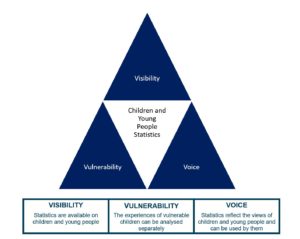The Covid-19 pandemic is having a profound impact on all parts of society. While statistically those medically hardest hit by the disease are the older generations, children and young people are having to come to terms with significant, immediate and possibly long term changes to their lives.
More than ever it is important that statistics about children and young people reflect the lived experiences of children. Statisticians play a key role in ensuring that the data collected and published about children and young people accurately reflects their needs and helps to inform policy and services that work to support them.
Our review
Prior to the pandemic we started reviewing the availability of statistics about children and young people with a view to better understanding their value in society and to determine whether:
- the current statistics are accessible, timely and help society to understand the experiences of children and young people in all aspects of their lives
- improvements are needed to the ways in which decisions on what to collect and analyse are reached
- the wider statistical system is responsive to the needs of users of statistics.
We want to see a step change in how the needs of children and young people are met by official statistics, where statistics producers consistently consider children and young people’s needs and voice during the design, collection, analysis and dissemination of statistics. The current pandemic and its aftermath make this all the more important.
Our initial research has looked at the strengths and weakness of the current statistics on children and young people. In doing so, we have identified three key lenses which, if applied through a structured framework, may support statistic producers to better meet users needs. This approach reflects the core principles set out in the UN Convention on the Rights of the Child.
Our proposed framework
We propose that producers of statistics consider children and young people through three lenses.
- Visibility – Statistics are available on children and young people
- Vulnerability – The experiences of vulnerable children can be analysed separately
- Voice – Statistics reflect the views of children and young people and can be used by them
For each lens of the framework we propose some key questions for statistics producers to consider.
Visibility – Statistics are available on children and young people
- Are children and young people visible in the statistics?
- Is data collected about them and then made available to inform decisions in the best interests of the child?
- Are decisions around what data to collect on and from children and young people transparent?
Vulnerability – The experiences of vulnerable children can be analysed separately
- Are the most vulnerable children visible?
- Is their experience identifiable to ensure that they are not being discriminated against?
- Do the statistics and data help identify which groups of children and young people are the most vulnerable to having poorer outcomes?
Voice – Statistics reflect the views of children and young people and can be used by them
- Are the views of children and young people represented in the statistics?
- Are survey questions asked to children and young people themselves?
- Do the statistics give them a voice on what is important to them by being understandable to them?
Your views are important to us
The next stage of our review is to test this framework approach with a wider set of users and statistics producers to see if this supports these aspirations. We hope also that sharing our initial thinking now may assist producers in their immediate decisions about what statistics and data they should be collecting and making available during and after the Covid-19 pandemic.
Are you a statistician trying to identify what data to collect and publish? Would this framework help you in making those decisions? Is there anything else that you feel could be considered? What would be the barriers to ensuring that children and young people are visible in the statistics, that the vulnerable can be separately analysed and that the statistics give children and young people a voice?
Are you a decision or policy maker using statistics to understand the lives of children and young people and the impact of decisions and policies on them? Does this framework cover the key elements that you feel are important? Is there anything else that you think statisticians should consider?
Are you a researcher using data and statistics to research children and young people’s lives and outcomes and the interventions that impact on them? Does this framework cover the key elements that you feel are important? Is there anything else that you think statisticians should consider? Are your needs adequately reflected by the framework?
Are you a child or young person or do you represent them? Are visibility, vulnerability and voice the key elements of statistics that are important to you? What are you most interested in when looking for statistics? What makes it difficult for you to find and use statistics?
Please get in touch to share your thoughts with us at regulation@statistics.gov.uk

